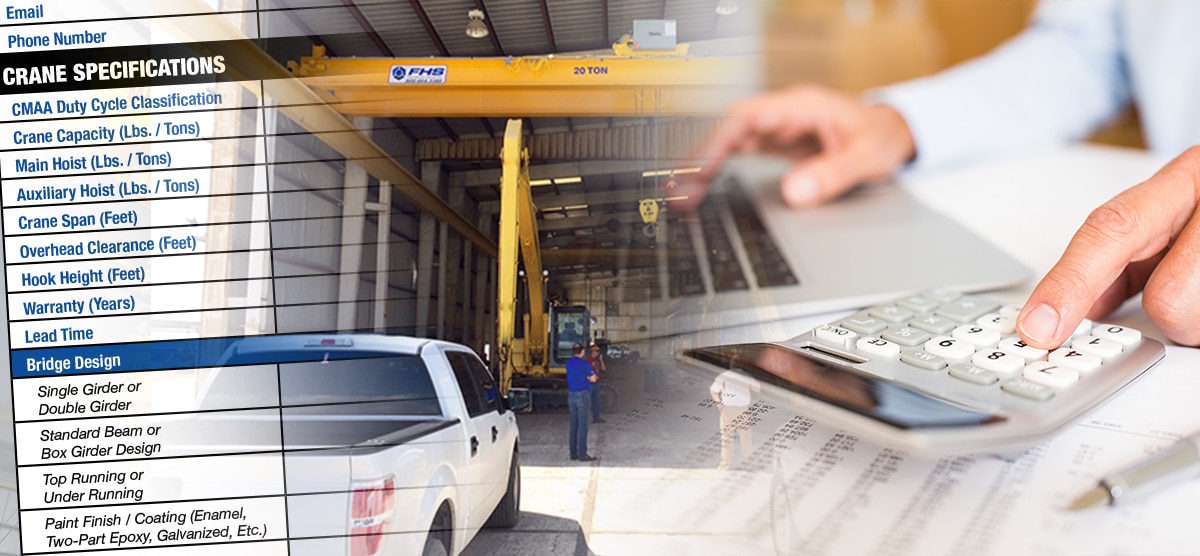How to Compare Overhead Crane Quotes
<p>Price shouldn't be the only factor when selecting an overhead crane company to partner with. Read on to get a comprehensive understanding of an overhead crane quote and what criteria you should use to compare multiple quotes.</p>
Price shouldn’t be the only factor when selecting an overhead crane company to partner with. Read on to get a comprehensive understanding of an overhead crane quote and what criteria you should use to compare multiple quotes.

Partnering with an overhead crane manufacturer is a big decision and one that should not be taken lightly. The design, manufacturing, and installation of an overhead crane system is an enormous investment, but a necessary one if you want to improve your company’s efficiency and workflows.
Get Multiple Quotes for Overhead Crane Installation
If you’re looking to finance your overhead crane equipment, then your bank may require you to have at least three overhead crane manufacturers bid on the project. Even if you know you won’t be financing the equipment, you should do your due diligence and have a couple of different crane companies look at your facility, provide a scope of work, and provide their expert opinion on the right overhead crane for your business.

Gain Perspective
Getting a couple of fresh sets of eyes on the project will help provide different options and opinions on the project. Each overhead crane builder may have a different idea or approach to go about solving your lifting and material handling challenges.
For example, one company may identify a potential problem or issue that another company overlooked. Or, if you have existing cranes in your facility, one company may want to completely replace them with new units, while another company may have a strategy for upgrading or modernizing your existing equipment at a significant cost-savings to your business.

Keep Costs Competitive
By having multiple manufacturers bid on your project, you will get a better sense of the true cost of buying and installing an overhead crane. Also, if a company knows that they aren’t the only ones bidding on the project, they will tend to provide a more comprehensive and competitive estimate and may be more willing to negotiate on the final purchase price to get your business.

Finding Overhead Crane Manufacturers to Bid on Your Project
It’s important to find the right company to partner with for your overhead crane project. There are a couple of different resources that you can use to research overhead crane manufacturers including referrals, industry events or trade shows, and utilizing the internet for research.

Ask for Referrals
Utilize industry connections to find out if other companies you know or work with have an overhead crane on-site. Reach out to current customers, vendors, or suppliers and find out if they utilize overhead lifting devices. If so, find out who they worked with, if they were happy with the partnership, and ask them if they’d be willing to provide a contact or make an introduction on your behalf.

Attend Industry Trade Shows or Events
You may luck out and find out that an overhead crane company that specializes in lifting equipment is already scheduled to exhibit at an industry show you’ll be attending.
Take a few minutes to visit the trade show’s website prior to the event and look at the list of exhibitors. See if there are any companies you’d be interested in speaking with—you may be able to contact them and schedule a quick introduction or consultation during the event.

Do Your Research Online
Use Google or other search engines to find local crane manufacturers that you might be able to work with. You may want to use search terms like, “overhead crane companies Cleveland OH,” or “overhead crane builders Charlotte NC.” Adding in a qualifier, like the city or state that you’re located in, will help to return companies that are located nearby. This could result in significant cost-savings to coordinate travel and freight when it comes time for the installation.
What Factors Affect the Cost of a Crane?
When a crane manufacturer comes on-site for a consultation, they’ll try to identify your specific lifting challenges, as well as evaluate your facility to get an understanding of the building’s floor space, support structures in place, and the size and capacity of the crane that they’ll be building.

Prior to their individual visits, it may help to put together some notes or a cheat sheet about your overhead lifting project. This will remind you to ask each company the same questions and also to provide them with the same specifications for your project so that each company builds their quote off of the same information.
Each of the following specifications will affect the cost of an overhead crane’s design and installation:
Total Number of Cranes
How many cranes will need to be designed, built, and installed?
Capacity
The capacity is the maximum load which may be applied to the crane, the hoist, or below-the-hook lifting device, in a particular working configuration and under a particular condition of use.
A crane’s capacity is a variable that takes many different factors into consideration and can best be calculated by the crane manufacturer. They can determine capacity based on their understanding of:
- The weight of the material that you’ll be lifting
- The rigging or below-the-hook lifters that will be attached
- Any other considerations for future usage or capabilities
Lift
Lift is how high into the air your material needs to be raised. When a team is calculating the lift capabilities of a crane, the following is taken into consideration:
- The height of any machinery or equipment on the floor that needs to be cleared
- The height of any racks or shelves that the material needs to be placed on
- The height or elevation of any pits, mines, or excavation sites that material will be lifted out of
- Overhead obstructions that can limit the hook height
- Elevation of an existing runway
Number of Lifts Per Hour
What is the duty cycle of this crane? Will it be making 2-5 lifts per hour at only 50% of its rated capacity? Or, will it be making 10-20 lifts per hours at, or near capacity, each time? Cranes in higher service classifications will require additional engineering and specialized components to solve complex lifting challenges.
Hook Approach
This is how close the crane hook can get to the end of a bridge or runway and considerations for the trolley hook approach, as well as the crane / runway hook approach. An under running crane will have a better trolley hook approach than a top running crane, so that may be a consideration if your crane needs to pick, or place, material near the walls or support structure within your facility.
Power
Will the crane be powered by electricity, hand-powered, or air-powered (pneumatic)?
Operating Environment
A severe, obstructed, or dangerous operating environment will affect the cost of an overhead crane. Environmental factors such as high heat, the presence of chemicals or fumes, steam, dust, or excess moisture can require special metal coatings to protect and enhance the operating life of the crane. It can also require special equipment or protection (PPE) for the installers during installation.
Obstructions can affect the cost of an overhead crane if the installers don’t have clear access to the area to remove an existing structure, or install a new one.
Operating Speed
The faster that the crane needs to operate, the more it will cost to design, source, and configure the individual crane components. A process crane making 10-20 lifts per hour will need a faster bridge, trolley, and hoist compared to a maintenance crane that requires more precision and slower speeds.
Controls
Considerations will have to be made as to how the operator is loading or unloading material:
- A radio control gives the operator free range to move around to position and adjust the load prior to raising or releasing it.
- A pendant can be festooned along the bridge of the crane, or be fixed to move with the hoist and trolley.
- Faster cranes and cranes that travel the length of the building, may require the operator to work from within an exposed or enclosed cab.
Span
The horizontal distance center-to-center of the runway rails. Cranes with large spans will be more expensive than smaller-span cranes due to the need for engineered girders.
Runway Location
Is there an existing runway in place? Is it sufficient to support the new crane structure? If a new runway system needs to be built, it will need to be determined if it will be mounted to new support columns, or if it can be tied back to the building. Is the building capable of supporting the new crane system? Is the flooring able to support the loads of the crane?
Consider any overhead or wall obstructions that may require additional design and engineering considerations. OSHA requires 3” clearance above the crane and 2” of clearance on the sides of the crane. Support columns cannot be put over drains, or on cracked or broken concrete.
How to Compare Overhead Crane Quotes
Once you’ve gone through the consultation process, a crane manufacturer will re-group with their team of estimators, engineers, and draftsmen and begin putting together a comprehensive proposal.

This process can take anywhere from 3-30 business days depending on the number of cranes being quoted, the complexity of the project, and the sourcing of crane components. Once they’ve completed this process, they’ll get back in touch with you to submit their official bid for the project.
Keep in mind that price should never be the only factor when selecting an overhead crane company to partner with. An overhead crane system is a complex and critical piece of equipment used to improve your business’ efficiency and production flows, and you should only partner with a company that you truly feel comfortable with.
Here are some things to consider when comparing overhead crane quotes:
Project Specifications
For a project of this scale, it’s so important that each company bases their quotes off of the same information and specifications so that you can make a true side-by-side comparison of each company’s capabilities and pricing.
If you get one bid that seems extraordinarily high or low, review their quote carefully and make sure that the specifications look right. You can also black out any pricing information from quotes you received from other bidders, and ask the outlying company to review the other quotes that you received—this ensures that what they’re quoting is a true apples-to-apples comparison and may allow them to adjust their quote, if necessary.
Warranty
Make sure you have a clear understanding of the manufacturer’s warranty policies on workmanship, components, and materials.
Incidentals
Any additional charges that may not appear in the quote. These can include:
- Price increases or surcharges tied into materials—like steel, for example
- Taxes, or freight charges, that may not have been included in the estimate
- Any additional fees related to obtaining permits, special equipment, or obstructed access for installation that may increase the cost of the project
Follow-Up
Did a representative from the company contact you to explain their quote and make sure that you understand and are comfortable with the breakdown of costs?
Project Timeline
Have they committed to meeting your project’s specific time frame and window for installation?
References
Have they provided, or can they provide, references for you to reach out to? Ask other companies that they’ve done business with if they were satisfied with the following:
- Overall relationship with the crane builder
- Overall quality of work
- Builder’s commitment to keeping project on track and within budget
- Delivery of crane to agreed-upon specifications
